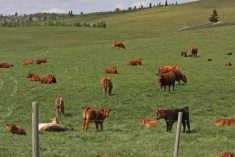COALDALE, Alta. — What to do with that living lettuce purchased with its roots attached?
Treat it like a houseplant, of course — a houseplant whose leaves you can eat.
The 20,000 heads of lettuce produced daily at Whole Leaf greenhouse all come with roots attached, a method of ensuring freshness.
“It does last longer,” said Whole Leaf senior director Rindi Bristol. “All you need to do is water it.”
Retailers who sell Inspired Greens, the label under which most of Whole Leaf’s product is marketed, are directed to display it at ambient temperature and avoid the misting common to many produce displays.
Read Also

Fuel rebate rule change will affect taxes and AgriStability
The federal government recently announced updates to the fuel rebates that farmers have been receiving since 2019-20.
“Most fruits and vegetables don’t come with the roots attached, so it’s been an uphill battle, trying to convince people that if you just water it, it will last,” Bristol said.
Properly handled, she said the lettuce will last three days to a week just sitting on the kitchen counter. Direct sunlight should be avoided, or the plants will start to grow and taste might be affected.
Some people cut the leaves as needed, but others go a different route, she added.
“I kind of thought that I would be a cutter… but I’ve actually found myself to be a tearer and a ripper. I’ll just pull off the leaves that I need and then I just pop it back into the sleeve and I leave it on my counter.
“We’re eating salad a lot more these days.”
Whole Leaf grows about 30 different varieties of lettuce and about 25 combinations. Bristol said the trios — three types of lettuce in one pot — have proven popular with consumers because they offer different tastes, colours and textures in one bunch, reducing potential waste.
















